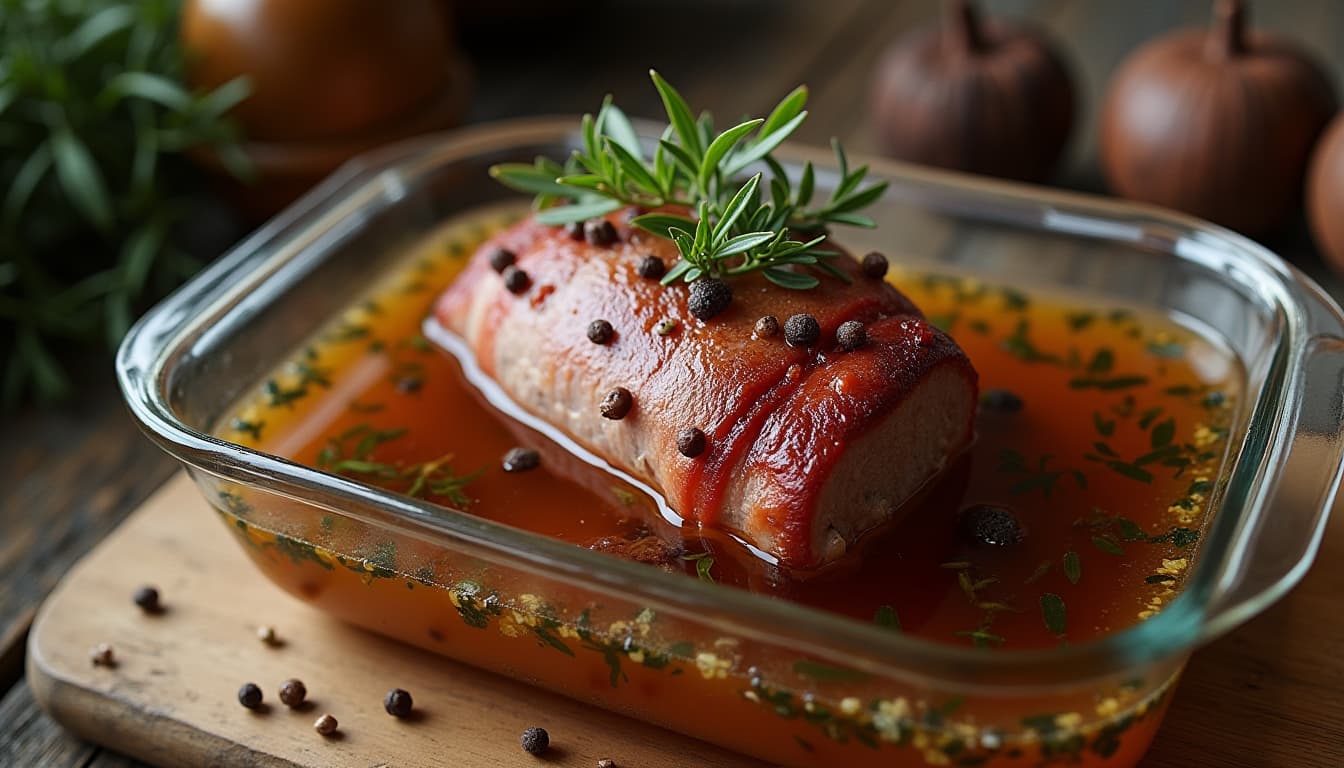Soaking naturally soak a deer roast enhances flavor. It also tenderizes the meat. This article explores what to use. Learn the best methods for a delicious roast.
Naturally Enhancing Deer Roast Flavor Through Soaking
Many hunters enjoy venison. Deer roast can be tough. Soaking the roast helps. It adds moisture and flavor. naturally soak a deer roast ingredients do this best. This makes the meat tender. It also makes it taste better.
Why Soak a Deer Roast Naturally?
Soaking isn’t just for flavor. It breaks down tough fibers. Therefore, you get a more tender roast. It’s also a natural way to reduce gamey taste. Soaking helps remove blood. Hence, the final result is better.
The Natural Science Behind Soaking
Osmosis is key. Water and flavorful liquids move into the meat. This natural process also draws out unwanted compounds. Thus, it’s a great way to tenderize. Salt in the soak is beneficial too. It also helps retain moisture. The final result is a juicy and delicious roast.
Natural Options for Soaking Your Deer Roast
There are many natural choices for soaking. Each offers unique flavors. Consider these options for your next roast. They each impart a natural taste.
Saltwater Brine: A naturally soak a deer roast Approach
Saltwater brines are a classic choice. Use about one tablespoon of salt per cup of water. This method is simple. It also naturally tenderizes the meat. This brine is a great base. Add other flavors to it too. Therefore, you can get the best results.
Buttermilk: A Natural Tenderizer
Buttermilk is another great option. The lactic acid in it tenderizes meat. This helps break down tough fibers. In addition, it adds a subtle tang. It provides a unique flavor profile. Buttermilk soaking makes for a very tender deer roast naturally.
Vinegar-Based Marinades: Natural Acidity
Vinegar is also a popular choice. It helps to break down the meat. Apple cider vinegar works well. It offers a mild, sweet taste. Furthermore, it is naturally effective. The acid tenderizes very effectively. Use it to enhance your deer roast.
Naturally Flavorful Fruit Juice Soaks
Fruit juices are great for tenderizing and flavor. Pineapple and citrus juices work best. These are naturally acidic. The acid also tenderizes the meat. However, do not soak too long. It can make the meat mushy. Therefore, use them with caution.
Preparing Your Deer Roast Naturally for Soaking
Proper preparation is needed before soaking. This ensures a successful result. Therefore, follow these steps. These steps will guide you on how to get the best outcome.
Trimming and Cleaning the Roast
Trim excess fat and silver skin. These parts do not break down well. They can also affect the flavor. Therefore, trimming them is important. Rinse the roast well. Make sure all blood is removed. This enhances the taste naturally.
Choosing the Right Soaking Vessel
Use a container that’s non-reactive. Glass or plastic works best. Avoid metal containers for soaking. Metal can react with acidic liquids. Thus, it can change the flavor. A large dish works well too. It’s important to make sure the roast is fully covered.
Preparing Your Chosen naturally soak a deer roast
Mix your chosen soaking liquid well. Ensure the salt and other seasonings are dissolved. For example, with a salt brine, it’s crucial to make sure the salt is completely dissolved. For juices or buttermilk, just make sure they’re thoroughly mixed. Now, you are ready to soak.
How Long Should You Naturally Soak a Deer Roast?
Soaking time depends on size and liquid used. Generally, 12 to 24 hours is good. For acid-based soaks, less time is needed.
Soaking Times for Various Natural Options
- Saltwater Brine: 12 to 24 hours.
- Buttermilk: 12 to 24 hours.
- Vinegar Marinades: 4 to 12 hours.
- Fruit Juice Soaks: 2 to 8 hours.
Monitoring the Soaking Process Naturally
Check your roast during the process. This ensures it’s not over-soaking. The meat should feel firmer. However, it shouldn’t feel mushy. Remove the roast when it is ready.
Tips for a Successful Soak
- Ensure the roast is fully submerged.
- Refrigerate the roast during soaking.
- Don’t reuse the soaking liquid.
- Rinse the roast after soaking.
- Pat it dry before cooking.
Naturally Enhancing Your Roast After Soaking
Soaking is just the first step. Enhance your roast with other flavors too. This will create a tasty dish. It also makes your deer roast memorable.
Natural Seasoning Options After Soaking
Use natural herbs and spices. Garlic, rosemary, and thyme work great. Salt and pepper are also crucial. Apply them generously. This will help enhance the taste.
Sear and Braise for Best Results
Searing the roast creates a nice crust. Then braise it in flavorful liquid. This will make the meat more tender. Use wine or broth for braising. It adds additional flavor layers.
Naturally Delicious Serving Suggestions
Serve with roasted vegetables. Potatoes, carrots, and onions work well. This makes a naturally delicious meal. The roast is now flavorful and tender.
Additional Natural Techniques for Tenderizing
There are other natural methods to tenderize a deer roast. These enhance the soaking process. They work well together to tenderize deer roast.
Pounding the Meat Before Soaking
Pounding breaks down the meat fibers. This also helps with soaking. Using a meat mallet is easy. This will result in more tender meat.
Using a Meat Thermometer
Use a meat thermometer to monitor temperature. This ensures the meat is cooked well. It also helps avoid overcooking. The internal temperature must be reached.
The Role of Natural Ingredients in Soaking
Understanding natural ingredients is important. It helps you make the best choices. Knowing their properties is key. Therefore, you will achieve the best result. Let’s look at each in more detail.
Salt: More Than Just Flavor
Salt is a key ingredient. It does more than add taste. It also aids in moisture retention. Salt helps naturally break down proteins. Consequently, the meat becomes more tender. The salt brine should be properly made. This ensures the best outcome.
Acidity: The Natural Tenderizer
Acidic liquids like vinegar work well. They break down tough muscle fibers. Buttermilk also achieves this. Fruit juices are also great for this purpose. The natural acidity makes meat very tender. Therefore, using it correctly is important.
Herbs and Spices: Infusing Natural Flavor
Herbs and spices add flavor. They penetrate the meat during soaking. Natural aromatics elevate the dish. They make it very fragrant and delicious. Use them to customize your flavors.
Water: The Base of Natural Soaking
Water is the foundation of many soaks. It carries the flavors into the meat. It helps facilitate the natural process of osmosis. Good quality water enhances results. Therefore, it is important to use it.
Natural Alternatives to Common Marinades
Some marinades have many additives. Therefore, exploring natural choices is good. It lets you control what goes into the food. Here are some great natural alternatives.
Replacing Store-Bought Marinades
Store-bought marinades often contain preservatives. They also have artificial flavors. Make your own natural version instead. Use fresh herbs and lemon juice. This provides a cleaner flavor. It also gives you more control.
Customizing Your Natural Marinade
Customize natural ingredients to suit your taste. Add chili flakes for some heat. Include garlic for more flavor. Adjust the ingredients as per your liking. This gives you the best outcome. You can also experiment with it as you like.
Why Choose Natural Over Store-Bought
Natural options are healthier. They are also more flavorful. You avoid unwanted additives and preservatives. You also achieve a more authentic taste. It’s also more satisfying.
Advanced Soaking Techniques for a Naturally Better Roast
There are advanced techniques too. They will take your roast to the next level. These methods enhance the basic soaking process. Hence, your results will be better.
Cold Soaking for Enhanced Flavor
Cold soaking is a great technique. It slows the process down. This allows for deeper flavor penetration. The roast stays cold. This is important for food safety. This method works very well.
Using a Vacuum Sealer for Natural Soaking
Vacuum sealers speed up marinating. They push the liquid into the meat. This is an effective way to soak the meat. It also ensures better contact. This ensures better results and quicker marinating time.
Double Soaking for Extra Tenderness
Some meats require extra soaking. This is especially true for tougher cuts. Soaking, rinsing, and soaking again works well. This method also results in more tender meat.
Understanding Different Cuts of Deer Meat and Soaking Needs
Different cuts require various approaches. Understanding this is essential. It can help you get the best out of every cut. Therefore, you will achieve the best results.
Identifying Various Deer Roast Cuts
The shoulder and leg are common cuts. Each cut requires different treatment. Understanding which cut you have is key. Hence, it will guide your cooking process.
Adjusting Soaking Times Based on the Cut
Tougher cuts like the shank need longer soaking. More tender cuts can use shorter soaks. Adjust your soaking times. This ensures optimal results. It also ensures that you will have a delicious meal.
Natural Soaking for Different Sizes
Smaller roasts need less soaking time. Larger roasts will require more time. Adjust soaking times according to the roast’s size. This ensures that it will be thoroughly tenderized. It also ensures that the final result will be the best.
Pairing Your Naturally Soaked Deer Roast with Complimentary Flavors
Flavor pairing enhances the overall experience. It allows you to enjoy your meal better. This is key for creating a well-rounded meal. It also enhances the taste.
Complementary Herbs and Spices
Rosemary, thyme, and juniper berries are great. They enhance the earthy taste of venison. Choose the flavor profile you like. Therefore, you will achieve the best outcome.
Natural Sauce Pairings for Deer Roast
A red wine reduction works well. A mushroom sauce is also a great choice. These sauces complement the venison taste. They make the dish very rich and satisfying.
Side Dish Ideas for Your Naturally Soaked Deer Roast
Roasted root vegetables pair well. Polenta or mashed potatoes also work very well. These side dishes complete the meal. They will also add additional texture and flavor.
Preserving and Reheating Your Naturally Soaked Deer Roast
Proper preservation is needed for leftovers. This maintains the quality of the meal. It also ensures that it will be just as delicious. Knowing how to reheat correctly is also important.
Storing Your Cooked Roast
Cool the roast first before storing it. Use an airtight container. Refrigerate promptly after cooling. This helps keep it safe and fresh.
Reheating Methods for Maintaining Tenderness
Reheat gently. Use low heat to prevent drying. Add some broth or sauce. This keeps the meat moist and tasty. Reheating too fast or too hot will ruin it.
Freezing Your Cooked Deer Roast
Freezing is a great option too. Wrap the roast well in plastic wrap. Place it in a freezer-safe bag. Thaw it in the fridge overnight for best results.
The Art of Slow Cooking and Naturally Soaked Deer Roast
Slow cooking enhances the benefits of soaking. This process allows for a deeper and richer taste. Therefore, you will achieve the best outcome.
Why Slow Cooking Works Well With Soaked Roast
Slow cooking helps the meat become extremely tender. The flavors penetrate deeply into the meat. This method is very effective. It also helps keep the meat moist.
Tips for Slow Cooking a Naturally Soaked Deer Roast
Use a low temperature. Cook for a long time. Ensure enough braising liquid. This prevents drying. This will help to ensure it comes out great.
Natural Slow Cooking Ingredients for Deer Roast
Add herbs and vegetables. Include wine or broth. Use natural flavor enhancers. These all contribute to a delicious meal. Using these ingredients is recommended.
Conclusion: Mastering the Art of Naturally Soaking Deer Roast
Soaking your deer roast naturally is essential. It improves taste and texture. Using these techniques is very useful. You’ll create tender, delicious venison. Enjoy the best results by using these methods.

